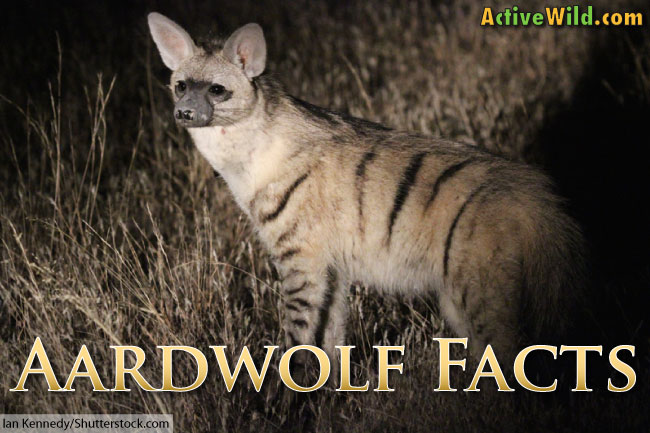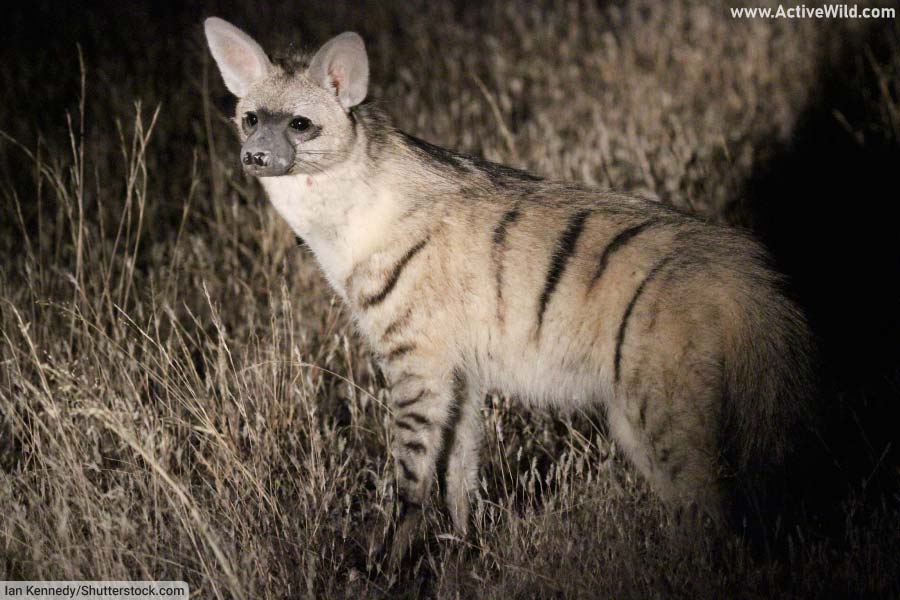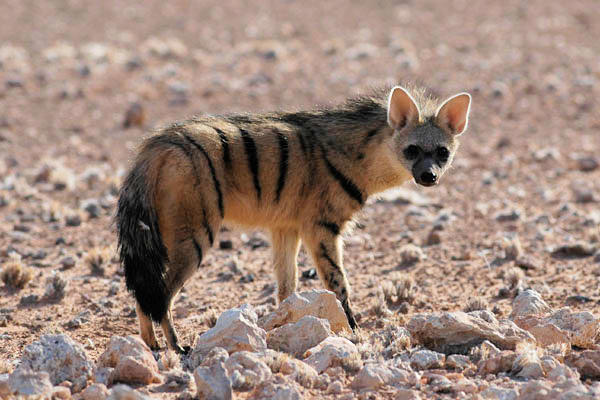Aardwolf facts, pictures and information. Discover the hyena’s insect-eating relative.
Aardwolf Facts At A Glance
- Other Name(s): Civet hyena
- Scientific name: Proteles cristata
- Type of Animal: Mammal
- Animal Family: Hyaenidae
- Where Found: Eastern, northeastern and southern Africa
- Head-Body Length: 55 to 80cm (22 to 31in)
- Tail Length: 20 to 30cm (7.9 to 11.8in)
- Shoulder Height: 40 to 50cm (16 to 20in)
- Weight: 7 to 15kg (15 to 33lb)
- Conservation Status: Least Concern
Other Interesting Aardwolf Facts:
- The aardwolf is a member of Hyaenidae, the hyena family. However, unlike the other three members of this family, the aardwolf doesn’t hunt or scavenge large animals. Instead, it is a specialized insectivore (insect eater) that mainly eats termites.
- The aardwolf can eat over a quarter of a million termites in one night!
Meet The Aardwolf: Introduction
The aardwolf is a nocturnal African mammal. It is a member of the hyena family, Hyaenidae (although some scientists argue that it should be placed into a family of its own).
The Four Species In The Family Hyaenidae
- Aardwolf Proteles cristatus
- Spotted hyena Crocuta crocuta
- Brown hyena Parahyaena brunnea
- Striped hyena Hyaena hyaena
Unlike the other hyenas, who eat the meat of vertebrates such as mammals, the aardwolf is primarily insectivorous (i.e. it eats insects).
The name ‘aardwolf’ means 'earth wolf' in Afrikaans (a language spoken in South Africa).
What Does The Aardwolf Look Like?
The aardwolf looks like a smaller, slender version of the striped hyena. Like all hyenas, it has a long neck and its front legs are longer than its back legs, giving its back a distinctive downward slope. The aardwolf has large ears, a black snout and a long, fox-like bushy tail.
A mane of dark, shaggy hair runs along the length of the aardwolf’s neck and back. This is raised when the aardwolf feels threatened, making the animal appear bigger that it actually is.
The aardwolf's coat ranges in color from pale yellow to golden orange, and there are black stripes on its body, neck and legs.
Watch the video below to see the aardwolf in the wild!
Distribution
The aardwolf is found in two separate regions of Africa. One population is found throughout southern Africa. Countries in which it is found include South Africa, Angola, Zambia and Mozambique.
The other population is found in eastern and northern Africa. Countries in which it is found include Egypt, Ethiopia, Somalia, Sudan, Tanzania and Uganda.
The two populations are separated by a distance of 1,500 km (931.5 mi.). Some scientists consider the two populations to be different subspecies, though the evidence supporting this is inconclusive.
The distribution range of the aardwolf overlaps largely with that of Trinervitermes termites, which comprise the aardwolf's main source of food.
Locate where thee aardwolf is found using the map below:
Habitat
The aardwolf's preferred habitat is open, grassy plains and bushland. Here the dead and withered grass supports large termite populations.
Other habitats in which the species may be found include: savannah, woodlands, inland gravel plains and farmland.
The aardwolf tends to avoid densely vegetated and mountainous areas, although in Ethiopia the species has been observed at an elevation 2,000m (6561ft) above sea level.
Aardwolf Territories
The aardwolf is shy and reclusive. It sleeps in underground burrows during the day and emerges at night to forage.
An aardwolf’s territory contains up to 10 dens. As well as those dug by the aardwolf itself, these may include the abandoned burrows of other animals (such as aardvarks) and sheltered spots such as crevices in rocks.
Usually the aardwolf rotates through all the available dens every 6 months or so, with only one or two dens in use at any one time.
The aardwolf either lives alone, with a mate, or in a small family group consisting of a mated pair and their young.
The size of an aardwolf’s territory is between 1 and 4 km2 (0.39 and 1.54 sq. mi), and the animal defends it either by chasing intruders off or fighting them. During aggressive encounters the aardwolf will raise its mane, roar, growl and bark.
Scarcity of food can cause aardwolves to temporarily abandon the territorial system.
Family Life
During the mating season, solitary males will roam their own territories as well as those of weaker rivals in search of females.
The gestation period of an aardwolf is around 90 days, with most cubs being born during the rainy months when termite activity is at its highest.
The female gives birth in a burrow. A typical litter comprises 2 or 3 cubs, but as many as 5 may be born. Each cub weighs about 200 to 350g (7.1 to 12.3 oz.).
The cubs spend their first 6 to 8 weeks in the den. Both parents play a part in looking after the young during this time. The male may stay and guard the den for several hours each night, giving the female time to forage.
At 3 months the cubs begin to forage under the supervision of their parents. At four months they are fully weaned, although they stay and share a den with their mother until the next breeding season.
What Do Aardwolves Eat?
The diet of the aardwolf is highly specialized, consisting almost exclusively of termites, particularly those of the genus Trinervitermes. The aardwolf can tolerate the toxic substance secreted by the soldier termites.
Species favored by the aardwolf include: Trinervitermes bettonianus in eastern Africa, Trinervitermes rhodesiensis in central Africa and Trinervitermes trinervoides in southern Africa.
The aardwolf gets most of the water it needs from eating termites.
The aardwolf typically forages alone, using the senses of smell and hearing to locate its food. Once a nest has been located, the aardwolf licks the termites up from the ground using its long, sticky tongue. A single aardwolf can eat between 200,000 and 300,000 termites every night.
The aardwolf is careful not to destroy the mound or eat the entire colony. This ensures that a source of food is always readily available. The aardwolf will memorize the location of the mound and return to it several months later.
The aardwolf’s teeth are specially adapted for eating insects, and unsuitable for chewing anything much more substantial than insects. However, when the aardwolf’s preferred termite species becomes scarce it will seek out other types of food. These include other termite species, other insects, larvae, eggs, and very occasionally small birds or mammals.
The aardwolf is not known either to prey on larger mammals or to scavenge.
Is The Aardwolf Endangered?
The aardwolf is rated 'Least Concern' by the IUCN.
The species appears to be fairly widespread and is found in numerous protected areas.
In the past aardwolves were occasionally persecuted by farmers, who believed that the species posed a threat to their livestock. In some areas agricultural and urban expansion have encroached into the aardwolf’s habitat.
Despite this, no major threats to the species as a whole are thought to exist.
Aardwolf Facts: Related Pages At Active Wild
- Explore the animal kingdom & discover more amazing animals: A to Z Animals, With Pictures & Facts
- Become an animal expert: Animals: The Ultimate Guide To The Animal Kingdom
- You can see more African animals here: African Animals





